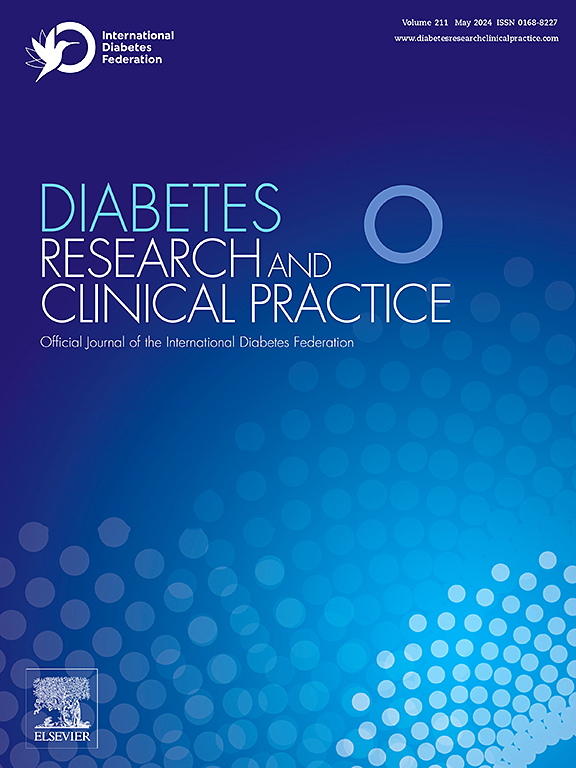COVID-19 大流行期间糖尿病筛查和运动在糖尿病前期成人中的变化
IF 6.1
3区 医学
Q1 ENDOCRINOLOGY & METABOLISM
引用次数: 0
摘要
目的评估在COVID-19安置期间2型糖尿病(T2DM)筛查和运动的变化,以及医疗补助患者和种族/少数民族群体是否受到不成比例的影响。方法:2019年1月至2021年12月,在北加州凯撒医疗机构对578,585名年龄≥18-89岁、BMI≥25(亚洲人≥23)的糖尿病前期成人进行回顾性队列研究。我们使用单独的中断时间序列分析,汇总每周T2DM筛查率或平均运动时间,以评估与就地避难相关的任何减少(2020年3月19日至2020年6月1日)。分析在2023-2024年进行。结果新冠肺炎前,T2DM筛查率为121/ 10000 /周,运动时间为107 min/周。最初,筛查下降到接近于零(约96%),随后缓慢增加7.4 (95% CI: 2.4-12.4, p值0.004)/10,000名患者/周。同样,运动最初减少了37 (29-45,p值<;0.001)分钟/周,随后缓慢增加3.5分钟/周(1.7-5.4,p值<;0.001)分钟/周。这些模式在种族/民族群体中是相似的;然而,医疗补助患者需要1.5年才能恢复到基线运动水平。结论:在糖尿病前期的成年人中,就地避难与T2DM筛查和运动的突然减少有关。未来的授权应支持高危人群,特别是医疗补助,维持T2DM筛查和锻炼以预防T2DM进展。本文章由计算机程序翻译,如有差异,请以英文原文为准。
Changes in diabetes screening and exercise during the COVID-19 pandemic in adults with prediabetes
Aims
To evaluate changes in type 2 diabetes mellitus (T2DM) screening and exercise during the COVID-19 shelter-in-place, and whether Medicaid patients and racial/ethnic minoritized groups were disproportionally affected.
Methods
Retrospective cohort study of 578,585 adults with prediabetes aged ≥ 18–89 years with BMI ≥ 25 (≥23 if Asian) at Kaiser Permanente Northern California from January 2019 to December 2021. We used separate interrupted time-series analyses of aggregated weekly T2DM screening rates, or mean exercise minutes, to evaluate any decrease associated with the shelter-in-place (March 19, 2020, to June 1, 2020). Analyses were performed in 2023–2024.
Results
Before Covid, 121/10,000 patients/week were screened for T2DM, and patients exercised 107 min/week. Initially, screening dropped to near zero (by ∼ 96 %) followed by a slow increase of 7.4 (95 % CI: 2.4–12.4, p-value 0.004)/10,000 patients/week during the shelter-in-place. Similarly, exercise decreased initially by 37 (29–45, p-value < 0.001) minutes/week, followed by a slow increase of 3.5 (1.7–5.4, p-value < 0.001) minutes/week during the shelter-in-place. These patterns were similar across racial/ethnic groups; however, Medicaid patients took 1.5 years to resume baseline exercise levels.
Conclusions
The shelter-in-place was associated with an abrupt decrease in T2DM screening and exercise among adults with prediabetes. Future mandates should support high-risk populations, especially Medicaid, to maintain T2DM screening and exercise to prevent T2DM progression.
求助全文
通过发布文献求助,成功后即可免费获取论文全文。
去求助
来源期刊

Diabetes research and clinical practice
医学-内分泌学与代谢
CiteScore
10.30
自引率
3.90%
发文量
862
审稿时长
32 days
期刊介绍:
Diabetes Research and Clinical Practice is an international journal for health-care providers and clinically oriented researchers that publishes high-quality original research articles and expert reviews in diabetes and related areas. The role of the journal is to provide a venue for dissemination of knowledge and discussion of topics related to diabetes clinical research and patient care. Topics of focus include translational science, genetics, immunology, nutrition, psychosocial research, epidemiology, prevention, socio-economic research, complications, new treatments, technologies and therapy.
 求助内容:
求助内容: 应助结果提醒方式:
应助结果提醒方式:


